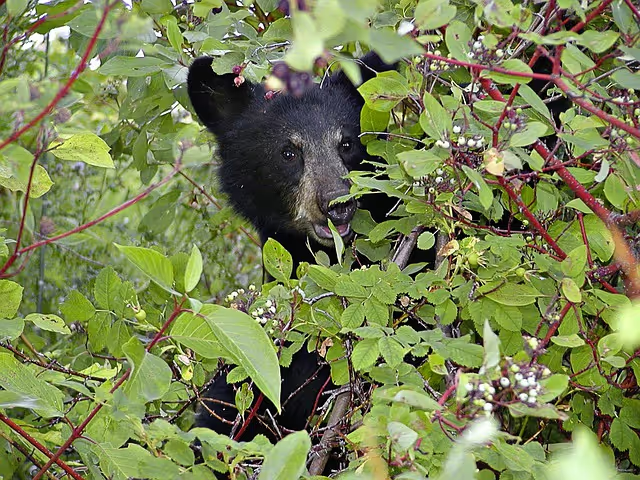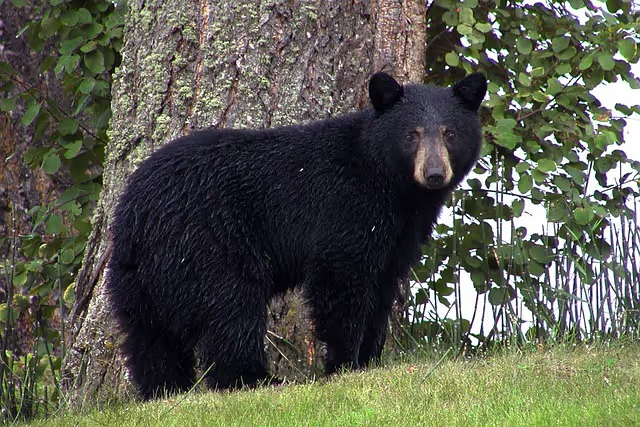Everything You Need to Know About Black Bears: Part 2


Welcome to the second part of our "Everything You Need To Know About Black Bears" series. Last month, we kicked off our introduction of this large mammal species that inhabits our little piece of coastal paradise. This month, we're going to continue our introduction by exploring the life cycle of a Black Bear, and digging into why Black Bears love trees so much. Here we go!

Life Cycle
Black Bears are mostly solitary creatures. They prefer to be left alone. However, there are a couple of exceptions to this rule. The first is when a female bear is raising her cubs. During this time, she needs to be near her offspring to offer protection and help grow into successful adult bears. The second is during mating season, which occurs in May and June each year (1).
Once a female Black Bear has finished mating for the year, she undergoes a process known as "delayed implementation" (1). During this process, the embryo that results from fertilization does not implant itself into the bear's uterus immediately. Instead, it waits until the time the mother enters her winter den, which allows the mother bear’s body to "physiologically ‘assess’ her condition before implantation occurs and the period of gestation leading to the birth of cubs really begins" (1). This process enables the mother to not drain precious energy and fat reserves in sustaining a potentially unsuccessful pregnancy because her condition is too poor (1).
Females generally give birth to cubs every other year, but may skip a year or two if food sources are scarce. The cubs are born in the mother's winter den and will den with her again the following winter before setting out on their own when they reach the age of eighteen months. A Black Bear litter can have anywhere from one to five cubs, though two is the most common (1). Black Bear cubs are small when they are first born, weighing less than a half a pound. By the time they emerge from their winter den, the cubs usually weigh around five pounds. However, they don't stay that small for long, as they can weigh as much as 80 pounds by the time they turn one (2). Black Bears can live up to 30 years in the wild. However, most unfortunately die before they are in their early 20s (1).
How Bears Leave Their Mark on Trees
Black Bears love trees. They enjoy climbing them, eating from them, and rubbing their backsides on them (3). Additionally, there has been some debate as to whether or not Black Bears also use trees to mark their territories (3). We will address these uses one by one.
Climbing
Young Black Bears climb trees regularly. If you're in an area with high bear density, you may see claw marks and hairs on trees. These indicate that a bear previously climbed them (3). Older bears are capable of climbing trees as well.
Food Source
Black Bears will use their teeth to rip off strips of bark from young conifer trees to gain access to insects or the sweet-tasting sap that can be found inside (3). Black Bears have strong teeth, and, as a result, leave long vertical grooves in the sapwood. Additionally, large strips of bark can be found around the bases of trees that they peel (3). These marks are typically only made from April to July each year. However, the results of this effort can be seen all year long (3). Black Bears prefer to conduct this particular variety of foraging in tree plantations where large stands of trees are of a single species and/or a similar age (3).
Rubbing and Scratching
Black Bears enjoy rubbing their backs against trees, particularly in the summer months. They do this to relieve themselves from what WDFW described as "the torment of parasites" that can inhabit a bear's fur (3). They also do this to loosen up their matted, thick winter coat.
Trees with rough bark are often serve as scratching posts. Once a Black Bear finds a good scratching tree, they will use it, sometimes for years. These trees are readily identifiable, courtesy of the large amounts of long fur that gets caught in the bark and sap (3).
Marking Their Territory
There has been some debate regarding whether or not Black Bears mark trees to mark their territory (3). While we don't know for certain whether or not bears actually use trees to mark their territory, we do know that they make marks that can be used for that purpose. These marks can be easily spotted on trees with smooth bark, such as Alder, Birch, and Aspen (3). Tooth and claw marks contrast with the greatest visibility on these trees. However, any tree, dead or alive, can be subjected to the marking treatment (3).
Next Time
That concludes the second part of our "Everything You Need To Know About Black Bears" series. Next month, we'll take a look at what Black Bears eat, and what you can do to keep these majestic creatures from becoming habituated to human food sources.
References
© Ian D. Caldwell, September 2022
Touch whale bones, examine shipwreck artifacts and connect with the coast's living history.

Support our mission, get involved in educational programs, or contribute through donations and volunteering.